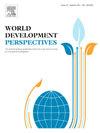Public and household financing of education in India: are they substitutes or complements?
IF 2.3
Q2 DEVELOPMENT STUDIES
引用次数: 0
Abstract
The present study investigates the relationship between public and household education expenditures in India from 1987 to 2018, using data from the National Sample Survey. Unlike previous studies that often considered education financing in isolation, this study employs an Intertemporal Utility Maximization framework to estimate the substitutability or complementarity between these expenditures. The analysis is based on the Auspitz-Lieben-Edgeworth-Pareto (ALEP) approach, diverging from the traditional Hicks-Allen method. By doing so, it extends the theoretical literature on the substitutability and complementarity of these expenditures under the ALEP framework. Empirical findings, derived from the Generalised Method of Moments in dynamic panel data analysis, indicate that public and household education expenditures in India are complementary. Specifically, increased public spending on education enhances the marginal utility of household education expenditure. These results are consistent under both linear and non-linear utility function specifications. The study concludes by emphasizing the importance of increasing public spending to provide essential amenities, thereby encouraging Indian households to invest more in their children’s education.
印度的公共和家庭教育资助:它们是替代品还是补充?
本研究使用国家抽样调查的数据,调查了1987年至2018年印度公共和家庭教育支出之间的关系。与以往研究通常孤立地考虑教育融资不同,本研究采用跨期效用最大化框架来估计这些支出之间的可替代性或互补性。该分析基于Auspitz-Lieben-Edgeworth-Pareto (ALEP)方法,与传统的Hicks-Allen方法不同。通过这样做,它扩展了在ALEP框架下这些支出的可替代性和互补性的理论文献。从动态面板数据分析中的广义矩法得出的实证结果表明,印度的公共和家庭教育支出是互补的。具体而言,公共教育支出的增加提高了家庭教育支出的边际效用。这些结果在线性和非线性效用函数规范下都是一致的。该研究的结论强调了增加公共支出以提供基本设施的重要性,从而鼓励印度家庭在孩子的教育上投入更多。
本文章由计算机程序翻译,如有差异,请以英文原文为准。
求助全文
约1分钟内获得全文
求助全文
来源期刊

World Development Perspectives
Social Sciences-Sociology and Political Science
CiteScore
4.50
自引率
0.00%
发文量
65
审稿时长
84 days
期刊介绍:
World Development Perspectives is a multi-disciplinary journal of international development. It seeks to explore ways of improving human well-being by examining the performance and impact of interventions designed to address issues related to: poverty alleviation, public health and malnutrition, agricultural production, natural resource governance, globalization and transnational processes, technological progress, gender and social discrimination, and participation in economic and political life. Above all, we are particularly interested in the role of historical, legal, social, economic, political, biophysical, and/or ecological contexts in shaping development processes and outcomes.
 求助内容:
求助内容: 应助结果提醒方式:
应助结果提醒方式:


